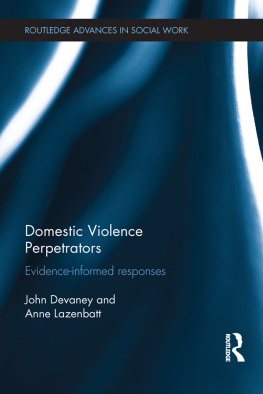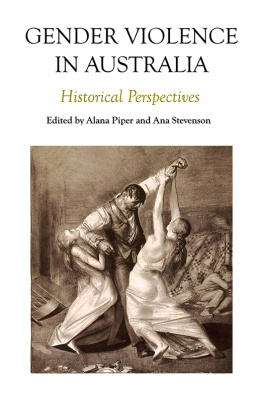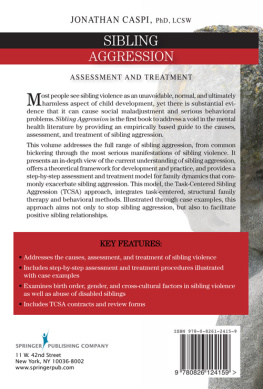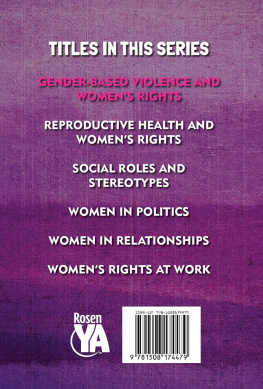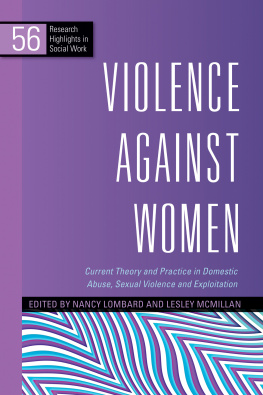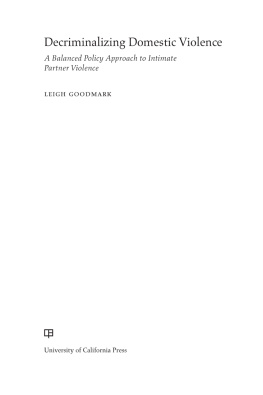Violence Within the Family
Violence Within
the Family
Social Psychological Perspectives
Sharon D. Herzberger
Trinity College
Social Psychology Series
John Harvey, Series Editor
Empathy: A Social Psychological Approach, Mark H. Davis
Violence Within the Family: Social Psychological Perspectives,
Sharon D. Herzberger
Social Dilemmas, Samuel S. Komorita and Craig D. Parks
Self-Presentation: Impression Management
and Interpersonal Behavior, Mark R. Leary
Experimental and Nonexperimental Designs in Social
Psychology, Abraham S. Ross and Malcolm Grant
Intergroup Relations, Walter G. Stephan and Cookie White Stephan
First published 1996 by Westview Press
Published 2018 by Routledge
52 Vanderbilt Avenue, New York, NY 10017, USA
2 Park Square, Milton Park, Abingdon, Oxon OX14 4RN
Routledge is an imprint of the Taylor & Francis Group, an informa business
Copyright 1996 Taylor & Francis
All rights reserved. No part of this book may be reprinted or reproduced or utilised in any form or by any electronic, mechanical, or other means, now known or hereafter invented, including photocopying and recording, or in any information storage or retrieval system, without permission in writing from the publishers.
Notice:
Product or corporate names may be trademarks or registered trademarks, and are used only for identification and explanation without intent to infringe.
Herzberger, Sharon D.
Violence within the family : social psychological perspectives /
Sharon D. Herzberger.
p. cm.
Includes bibliographical references and index.
ISBN 0-8133-3002-5 (pbk.)
1. Family violence. 2. Family violencePsychological aspects.
I. Title.
HV6626.H43 1996
362.8292dc20 96-1278
CIP
ISBN 13: 978-0-8133-3002-0 (pbk)
CONTENTS
Pick up any newspaper and you can probably find a story about a case of family violence. One prominently featured case involved two brothers who killed their parents to escape from abuse (as the defense claimed) or to inherit their parents estate (as the prosecution con-tended). Another story featured a wife who mutilated her husband allegedly after being raped. Less sensational stories, receiving only fleeting and local concern, can be found almost daily. Although we like to think of our home as a place of refuge and support, the stories remind us that the home can be dangerous and depressing for all too many people.
Perhaps one-fifth of all marriages are tainted by violence, and an equal number of parents may harm their children. Violence against elderly relatives is not well understood, but we are beginning to recognize it as a major social problem. And the most common form of family violence, receiving little attention and less sympathy, occurs between siblings. We do not even understand its impact.
Over the years there have been many books written on family violence. This book is different because it places the topic of family violence within the disciplinary perspectives of social psychology. Family violence is an ideal subject for the application of social psychological theory and research. It draws upon the familiar topics of aggression, attitude formation and change, self-perception, social cognition, gender roles, and group processes. In this book you will learn about the biological and social causes of aggression within families and its consequences. You also will study ways to prevent violence, as well as to treat it, and examine characteristics of families that facilitate or inhibit the use of aggression to solve conflicts. Finally, the book investigates how society reacts to aggression against family members and how the reaction has changed over time and varies across groups.
The book provides an overview of research on child abuse, partner abuse, abuse against elderly relatives, and sibling violence, but it does not cover all types of violence. Its focus is on physical violence; sexual and emotional maltreatment are discussed occasionally, but only when relevant to the primary topic of physical abuse. This book addresses such questions of current interest as: Does a child who is abused grow up to become an abuser? Can anyone become an abuser, given the right circumstances? Why do victims of partner abuse stay with the perpetrator? Should we arrest perpetrators of family violence? What are the impediments to successful prosecution of crimes against family members? And, Why do people demean victims of family violence?
The book is intended for advanced undergraduate students in special topics classes or as an accompaniment to a text in an introductory social psychology course. But it is also designed to be read by intelligent laypeople who want to understand this difficult and widespread social problem.
I want to thank several people for their diligent help with this volume. First, I thank Trinity students, Kirsten Olson and Kristin Maki, who helped me to find interesting material to include in the book and who commented upon early drafts of each chapter. My secretary, Tracy Knight, provided invaluable editorial and organizational help. Reviewers, Robert Burgess of Pennsylvania State University, Irene Frieze of the University of Pittsburgh, and John Harvey of the University of Iowa made insightful suggestions on the first draft of the manuscript. I am most grateful, however, to my husband, David, for encouraging me throughout this process and to my parents, Marion and Robert Dickman, whose love and support during my childhood provided an environment so contrary to those featured in this book.
CHAPTER
1
The Incidence of Family Violence
CHAPTER OBJECTIVES
What Do We Mean by Family Violence?
Rates of Family Violence
The Validity of Information about Violence
Child Abuse
Spouse Abuse
Sibling Violence
Elderly Abuse
Multiple Forms of Violence in the Family
Violence in the Home versus outside the Home
Universality of Violence against Family Members
Cross-Cultural Variations
Temporal Variations
Concluding Remarks
We are supposed to feel safe at home. Home should be where we are loved, protected, and restored after a day at work or school. For many people, however, the home is not a safe haven from the stresses of life. Instead, it is a dangerous place where mental, physical, or sexual suffering occurs, often on a regular basis.
This book explores physical violence within families from the perspectives offered by social psychology. Social psychologists are interested in the forces that affect our behavior in the social world. They study the influence individuals or groups have on other people and how, in turn, the individual influences the surrounding environment. Social psychologists recognize that reality is in the eyes of the perceiver and that to understand a persons behavior or thoughts, we must understand how the individual interprets and evaluates the behaviors of others. Gordon Allport (1985) said this well: Social psychologists attempt to understand and explain how the thought, feeling, and behavior of individuals are influenced by the actual, imagined, or implied presence of others (p. 3).


